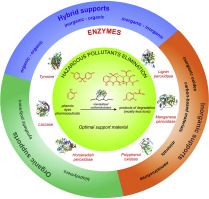Advances in Colloid and Interface Science ( IF 15.9 ) Pub Date : 2018-07-24 , DOI: 10.1016/j.cis.2018.07.004 Jakub Zdarta , Anne S. Meyer , Teofil Jesionowski , Manuel Pinelo

|
Bioremediation, a biologically mediated transformation or degradation of persistent chemicals into nonhazardous or less-hazardous substances, has been recognized as a key strategy to control levels of pollutants in water and soils. The use of enzymes, notably oxidoreductases such as laccases, tyrosinase, various oxygenases, aromatic dioxygenases, and different peroxidases (all of EC class 1) is receiving significant research attention in this regard. It should be stated that immobilization is emphasized as a powerful tool for enhancement of enzyme activity and stability as well as for protection of the enzyme proteins against negative effects of harsh reaction conditions. As proper selection of support materials for immobilization and their performance is overlooked when it comes to comparing performance of immobilized enzyme in academic studies, this review summarizes the current state of knowledge regarding the materials used for enzyme immobilization of these oxidoreductase enzymes for environmental applications. In the presented study, thorough physicochemical characteristics of the support materials was presented. Moreover, various types of reactions and notably operational modes of enzymatic processes for biodegradation of harmful pollutants are summarized, and future trends in use of immobilized oxidoreductases for environmental applications are discussed. Our goal is to provide an improved foundation on which new technological advancements can be made to achieve efficient enzyme-assisted bioremediation.
中文翻译:

固定化氧化还原酶支持材料的进展:全面综述
生物修复是将持久性化学物质生物转化或降解为无害或危害较小的物质的一种生物媒介,已被认为是控制水和土壤中污染物水平的关键策略。在这方面,酶的使用,特别是氧化还原酶(如漆酶,酪氨酸酶,各种加氧酶,芳香族双加氧酶和不同的过氧化物酶)的使用正受到广泛的研究关注。应该指出的是,固定化是增强酶活性和稳定性以及保护酶蛋白抵抗恶劣反应条件的不利影响的有力工具。在学术研究中比较固定化酶的性能时,忽视了正确选择用于固定化的支持材料及其性能的方法,这篇综述总结了有关用于环境应用的这些氧化还原酶的酶固定材料的当前知识状态。在提出的研究中,介绍了载体材料的全面理化特性。此外,总结了各种类型的反应,尤其是酶促方法对有害污染物进行生物降解的操作模式,并讨论了在环境应用中使用固定化氧化还原酶的未来趋势。我们的目标是提供一个改进的基础,在此基础上可以取得新的技术进步,以实现有效的酶辅助生物修复。在提出的研究中,介绍了载体材料的全面理化特性。此外,总结了各种类型的反应,尤其是酶促方法对有害污染物进行生物降解的操作模式,并讨论了在环境应用中使用固定化氧化还原酶的未来趋势。我们的目标是提供一个改进的基础,在此基础上可以取得新的技术进步,以实现有效的酶辅助生物修复。在提出的研究中,介绍了载体材料的全面理化特性。此外,总结了各种类型的反应,尤其是酶促方法对有害污染物进行生物降解的操作模式,并讨论了在环境应用中使用固定化氧化还原酶的未来趋势。我们的目标是提供一个改进的基础,在此基础上可以取得新的技术进步,以实现有效的酶辅助生物修复。











































 京公网安备 11010802027423号
京公网安备 11010802027423号